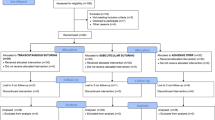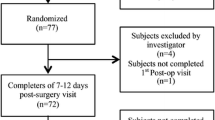Abstract
Background
Abdominoplasty is one of the most commonly performed procedures in plastic surgery. The appearance of the scar is a major factor that contributes to the aesthetic outcome of the procedure and depends largely on the technique of wound closure. The new Prineo™ wound closure system was introduced to combine the effectiveness of 2-octyl cyanoacrylate (Dermabond™) together with a self-adhering mesh.
Methods
Fifty-two women and eight men aged between 21 and 65 years who were scheduled for abdominoplasty were included in the study. The total operating times after abdominoplasty of the traditional wound closure technique and the Prineo™-type wound closure technique were compared. Furthermore, an analysis comparing the cost of the two methods was performed. Two weeks after surgery the wounds were examined and graded using the Hollander Cosmesis Scale. At the 6- and 12-month follow-ups, the aesthetic outcome of the abdominal scar was evaluated using the Vancouver Scar Scale. Twelve months after surgery, the patients were asked to answer their part of the Patient Scar Assessment Scale.
Results
The mean total operating time for the new skin closure system was statistically significantly shorter than that of intradermal sutures. The mean price difference per patient was 104.27€ (134.79$) in favor of Prineo™. The Hollander Cosmesis Scale indicated a significantly more favorable overall result with Prineo™ at 2 weeks after surgery. The Vancouver Scar Scale demonstrated a better cosmetic outcome in favor of Prineo™ 6 and 12 months after surgery. The Patient Scar Assessment Scale scores 12 months after surgery indicated that the patients noted significantly less pain, thickness, and irregularity with Prineo™.
Conclusion
Based on our results, we conclude that Prineo™ is a safe and effective substitute for superficial skin closure, with good cosmetic results and no increase in wound complications. The use of Prineo™ decreases operative time and cost and enhances the patient’s postoperative comfort.
Level of Evidence I
This journal requires that authors assign a level of evidence to each article. For a full description of these Evidence-Based Medicine ratings, please refer to the Table of Contents or the online Instructions to Authors www.springer.com/00266.







Similar content being viewed by others
References
Singer AJ, Hollander JE, Valentine SM, Turque TW, McCuskey CF, Quinn JV (1998) Prospective, randomised controlled trial of tissure adhesive (2-octylcyanoacrylate) vs standard wound closure techniques for laceration repair. Acad Emerg Med 5:94–99
Hollander JE, Singer AJ, Valentine SM, Henry MC (1995) Wound registry: development and validation. Ann Emerg Med 25:657–685
Mattick A, Clegg G, Beattie T, Ahmad T (2002) A randomised, controlled trial comparing a tissue adhesive (2-octylcyanoacrylate) with adhesive strips (Steristrips) for paediatric laceration repair. Emerg Med J 19:405–407
Toriumi DM, O’Grady K, Desai D, Bagal A (1998) Use of octyl-2-cyanoacrylate for skin closure in facial plastic surgery. Plast Reconstr Surg 102:209–219
Quinn JV, Drzewiecki AE, Stiell IG, Elmslie TJ (1995) Appearance scales to measure cosmetic outcomes of healed lacerations. Am J Emerg Med 13:229–231
Draaijers LJ, Tempelman FR, Botman Y et al (2004) The patient and observer scar assessment scale: a reliable and feasible tool for scar evaluation. Plast Reconstr Surg 113:1960–1965
Richter D, Stoff A, Ramakrishnan V, Exner K, Jernbeck J, Blondeel PN (2012) A comparison of a new skin closure device and intradermal sutures in the closure of full-thickness surgical incisions. Plast Reconstr Surg 130(4):843–850
Huemer GM, Schmidt M, Helml GH, Shafighi M, Dunst-Huemer KM (2012) Effective wound closure with a new two-component wound closure device (Prineo™) in excisional body-contouring surgery: experience in over 200 procedures. Aesthetic Plast Surg 36(2):382–386
Chamberlain RS, Patil S, Minja EJ, Kordears K 4th (2012) Does residents’ involvement in mastectomy cases increase operative cost? If so, who should bear the cost? J Surg Res 178(1):18–27
Von Strauss Und Torney M, Dell-Kuster S, Mechera R, Rosenthal R, Langer I (2012) The cost of surgical training: analysis of operative time for laparoscopic cholecystectomy. Surg Endosc 26(9):2579–2586
Hosler MR, Scott IU, Kunselman AR, Wolford KR, Oltra EZ, Murray WB (2012) Impact of resident participation in cataract surgery on operative time and cost. Ophthalmology 119(1):95–98
Gennari R, Rotmensz N, Ballardini B et al (2004) A prospective, randomized, controlled clinical trial of tissue adhesive (2-octylcyanoacrylate) versus standard wound closure in breast surgery. Surgery 136:593–599
Ong J, Ho KS, Chew MH et al (2010) Prospective randomised study to evaluate the use of DERMABOND ProPen (2-octylcyanoacrylate) in the closure of abdominal wounds versus closure with skin staples in patients undergoing elective colectomy. Int J Colorectal Dis 25:899–905
Singer AJ, Quinn JV, Clark RE, Hollander JE, the TraumaSeal Study Group (2002) Closure of lacerations and incisions with octylcyanoacrylate: a multicentric randomised controlled trial. Surgery 131:270–276
Hall LT, Bailes JE (2005) Using Dermabond for wound closure in lumbar and cervical neurosurgical procedures. Neurosurgery 56:147–150
Bernard L, Doyle J, Friedlander SF, Eichenfield LF, Gibbs NF, Cunningham BB (2001) A prospective comparison of octyl cyanoacrylate tissue adhesive (Dermabond) and suture for the closure of excisional wounds in children and adolescents. Arch Dermatol 137:1177–1180
Nipshagen MD, Hage JJ, Beekman WH (2008) Use of 2-octyl-cyanoacrylate skin adhesive (Dermabond) for wound closure following reduction mammaplasty: a prospective, randomized intervention study. Plast Reconstr Surg 122:10–18
Scott GR, Carson CL, Borah GL (2007) Dermabond skin closures for bilateral reduction mammaplasties: a review of 255 consecutive cases. Plast Reconstr Surg 120:1460–1465
Bhende S, Rothenburger S, Spangler DJ, Ditto M (2002) In vitro assessment of microbial barrier properties of Dermabond topical skin adhesive. Surg Infect (Larchmt) 3:251–257
Nitsch A, Pabyk A, Honig JF, Verheggen R, Merten HA (2005) Cellular, histomorphologic, and clinical characteristics of a new octyl-2-cyanoacrylate skin adhesive. Aesthetic Plast Surg 29:53–58
Acknowledgments
The authors express their gratitude to the surgeons and staff of the Division of Plastic, Aesthetic and Reconstructive Surgery, Department of Surgery, Medical University of Graz.
Conflict of interest
The authors have no financial disclosures, commercial associations, or conflicts of interest to report.
Author information
Authors and Affiliations
Corresponding author
Rights and permissions
About this article
Cite this article
Parvizi, D., Friedl, H., Schintler, M.V. et al. Use of 2-Octyl Cyanoacrylate Together with a Self-Adhering Mesh (Dermabond™ Prineo™) for Skin Closure Following Abdominoplasty: An Open, Prospective, Controlled, Randomized, Clinical Study. Aesth Plast Surg 37, 529–537 (2013). https://doi.org/10.1007/s00266-013-0123-3
Received:
Accepted:
Published:
Issue Date:
DOI: https://doi.org/10.1007/s00266-013-0123-3




